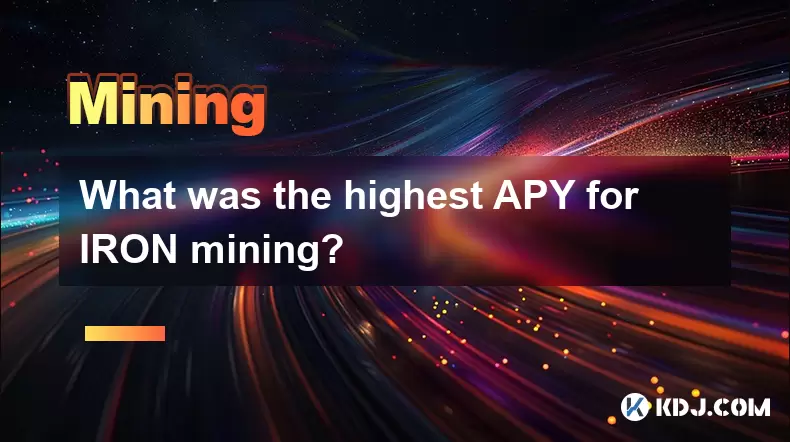-
 Bitcoin
Bitcoin $115000
0.12% -
 Ethereum
Ethereum $3701
4.50% -
 XRP
XRP $3.081
2.99% -
 Tether USDt
Tether USDt $0.0000
-0.01% -
 BNB
BNB $767.9
1.45% -
 Solana
Solana $169.5
3.13% -
 USDC
USDC $0.9999
0.01% -
 Dogecoin
Dogecoin $0.2106
4.30% -
 TRON
TRON $0.3334
1.62% -
 Cardano
Cardano $0.7564
2.54% -
 Stellar
Stellar $0.4165
0.76% -
 Hyperliquid
Hyperliquid $38.75
0.25% -
 Sui
Sui $3.593
3.00% -
 Chainlink
Chainlink $17.08
3.59% -
 Bitcoin Cash
Bitcoin Cash $573.6
4.35% -
 Hedera
Hedera $0.2508
-0.84% -
 Avalanche
Avalanche $23.07
6.46% -
 Ethena USDe
Ethena USDe $1.001
-0.02% -
 Litecoin
Litecoin $120.8
8.17% -
 UNUS SED LEO
UNUS SED LEO $8.943
-0.32% -
 Toncoin
Toncoin $3.400
-5.60% -
 Shiba Inu
Shiba Inu $0.00001255
1.54% -
 Uniswap
Uniswap $9.908
6.32% -
 Polkadot
Polkadot $3.718
2.10% -
 Monero
Monero $303.0
-0.74% -
 Dai
Dai $0.9999
-0.02% -
 Bitget Token
Bitget Token $4.392
0.91% -
 Cronos
Cronos $0.1403
6.31% -
 Pepe
Pepe $0.00001076
1.13% -
 Aave
Aave $267.2
1.80%
How do mining equipment for Dogecoin mining deal with hardware failures?
Dogecoin mining equipment uses monitoring software to detect failures, followed by diagnosis and immediate action to mitigate issues, ensuring minimal downtime.
Apr 03, 2025 at 09:15 am

Dogecoin mining, like other forms of cryptocurrency mining, relies heavily on specialized hardware to perform the necessary computations to mine new coins. However, as with any technology, mining equipment can encounter hardware failures. This article will explore how mining equipment for Dogecoin mining deals with such failures, covering various aspects from detection to resolution.
Detection of Hardware Failures
The first step in dealing with hardware failures in Dogecoin mining equipment is detecting the problem. Modern mining rigs are equipped with monitoring software that continuously tracks the performance of each component. This software can detect anomalies such as sudden drops in hash rates, unexpected temperature spikes, or unusual power consumption patterns. When such anomalies are detected, the software alerts the miner, often through notifications on a connected device or via email.
Diagnosing the Issue
Once a potential hardware failure is detected, the next step is to diagnose the issue. Miners typically use diagnostic tools that can provide detailed information about the health of their hardware. These tools can identify whether the problem is with the GPU, CPU, memory, or another component. For instance, if a GPU is overheating, the diagnostic tool might indicate that the GPU's temperature is consistently above the safe threshold. This information helps miners understand the root cause of the failure and plan their next steps accordingly.
Immediate Actions to Mitigate Failures
Upon diagnosing a hardware failure, miners need to take immediate action to mitigate the issue and prevent further damage. Here are some common steps miners might take:
- Power down the affected equipment: If a component is overheating or showing signs of failure, it's crucial to power down the system to prevent further damage.
- Isolate the faulty component: If possible, isolate the faulty component from the rest of the system to ensure that other parts are not affected.
- Check for loose connections: Sometimes, hardware failures can be due to loose connections. Checking and securing all connections can sometimes resolve the issue without needing to replace parts.
Repairing or Replacing Faulty Hardware
Once the immediate actions are taken, miners need to decide whether to repair or replace the faulty hardware. This decision depends on several factors, including the cost of repair versus replacement, the age of the equipment, and the availability of spare parts. Here are some considerations:
- Repairing: If the issue is minor, such as a faulty fan or a loose connection, repairing the equipment might be the most cost-effective solution. Miners can often perform minor repairs themselves or hire a professional technician.
- Replacing: For more severe issues, such as a damaged GPU or motherboard, replacing the component might be necessary. Miners need to consider the cost of new hardware and the potential downtime of their mining operation when making this decision.
Preventive Maintenance to Reduce Failures
To minimize the risk of hardware failures, miners can implement a regular preventive maintenance schedule. This can include:
- Regular cleaning: Dust and debris can cause overheating and other issues. Regularly cleaning the mining equipment, especially the fans and vents, can help maintain optimal performance.
- Temperature monitoring: Keeping an eye on the temperatures of critical components can help miners address overheating issues before they lead to failures.
- Firmware and software updates: Keeping the mining software and firmware up to date can improve the stability and efficiency of the mining operation, reducing the likelihood of hardware failures.
Utilizing Redundancy to Minimize Downtime
Another strategy to deal with hardware failures in Dogecoin mining is to implement redundancy in the mining setup. This means having backup components or even entire rigs that can take over if a primary unit fails. Here are some ways miners can use redundancy:
- Backup GPUs: Having spare GPUs on hand can allow miners to quickly replace a faulty unit and resume mining with minimal downtime.
- Redundant power supplies: Using multiple power supplies can ensure that the mining operation continues even if one power supply fails.
- Distributed mining setups: Spreading the mining operation across multiple locations can also provide redundancy, as a failure in one location does not affect the entire operation.
Insurance and Warranty Considerations
Many miners invest in insurance and extended warranties to protect against the financial impact of hardware failures. Here are some key points to consider:
- Warranty coverage: Checking the warranty coverage for each component can help miners understand what repairs or replacements are covered and for how long.
- Insurance policies: Some insurance policies specifically cover mining equipment, providing financial protection against hardware failures and other risks.
- Service contracts: Some manufacturers and third-party providers offer service contracts that include regular maintenance and repair services, which can be beneficial for miners.
Community and Professional Support
The Dogecoin mining community can be a valuable resource for miners dealing with hardware failures. Online forums, social media groups, and dedicated mining communities often share tips, advice, and experiences related to hardware issues. Additionally, professional support from technicians and service providers can be crucial for more complex problems. Here are some ways miners can leverage community and professional support:
- Online forums: Platforms like Reddit and specialized mining forums can provide insights and solutions from experienced miners.
- Social media groups: Joining groups dedicated to Dogecoin mining can connect miners with others who have faced similar issues.
- Professional technicians: For more complex hardware failures, hiring a professional technician can ensure that the problem is correctly diagnosed and fixed.
Case Studies and Real-World Examples
To illustrate how miners deal with hardware failures, let's look at a few real-world examples:
- Case Study 1: A miner noticed a sudden drop in hash rate and used diagnostic software to identify a faulty GPU. By quickly replacing the GPU with a spare, the miner minimized downtime and continued mining without significant loss.
- Case Study 2: Another miner experienced frequent overheating issues due to dust accumulation. By implementing a regular cleaning schedule, the miner was able to reduce the frequency of hardware failures and improve overall mining efficiency.
- Case Study 3: A large-scale mining operation used redundancy by having multiple rigs in different locations. When one rig failed due to a power supply issue, the other rigs continued to operate, minimizing the impact on the overall mining output.
Common Questions Related to Dogecoin Mining Hardware Failures
Q1: How can I detect hardware failures in my Dogecoin mining setup?
A1: Use monitoring software that tracks the performance of each component. Look for anomalies such as sudden drops in hash rates, unexpected temperature spikes, or unusual power consumption patterns. These tools will alert you to potential issues.
Q2: What should I do immediately after detecting a hardware failure?
A2: Power down the affected equipment to prevent further damage. Isolate the faulty component if possible and check for loose connections. These immediate actions can help mitigate the issue and protect other parts of your mining setup.
Q3: Should I repair or replace faulty hardware in my Dogecoin mining rig?
A3: It depends on the severity of the issue, the cost of repair versus replacement, and the age of the equipment. Minor issues like faulty fans or loose connections can often be repaired, while more severe issues like damaged GPUs might require replacement.
Q4: How can I prevent hardware failures in my Dogecoin mining operation?
A4: Implement a regular preventive maintenance schedule that includes cleaning, temperature monitoring, and firmware/software updates. These practices can help maintain optimal performance and reduce the risk of failures.
Q5: What is the role of redundancy in dealing with hardware failures?
A5: Redundancy involves having backup components or entire rigs that can take over if a primary unit fails. This can minimize downtime and ensure that your mining operation continues even if one part fails.
Q6: Can insurance and warranties help with hardware failures in Dogecoin mining?
A6: Yes, many miners invest in insurance and extended warranties to protect against the financial impact of hardware failures. Checking warranty coverage and considering insurance policies can provide financial protection and peace of mind.
Q7: How can the Dogecoin mining community help with hardware failures?
A7: The Dogecoin mining community can provide valuable insights and solutions through online forums, social media groups, and dedicated mining communities. Professional technicians can also be hired for more complex issues, ensuring that problems are correctly diagnosed and fixed.
Disclaimer:info@kdj.com
The information provided is not trading advice. kdj.com does not assume any responsibility for any investments made based on the information provided in this article. Cryptocurrencies are highly volatile and it is highly recommended that you invest with caution after thorough research!
If you believe that the content used on this website infringes your copyright, please contact us immediately (info@kdj.com) and we will delete it promptly.
- Bitcoin, Fed Rate Cut, and Crypto Stocks: A New Yorker's Take
- 2025-08-05 14:50:12
- Police, Cryptocurrency, Bitcoin Windfall: Unexpected Gains and Cautionary Tales
- 2025-08-05 15:30:12
- MAGACOIN: The Next Shiba Inu ROI? A Crypto Presale Deep Dive
- 2025-08-05 15:30:12
- Bitcoin, Kiyosaki, and the August Curse: Will History Repeat?
- 2025-08-05 14:50:12
- Crypto Airdrops: Your August 2025 Guide to Free Tokens & Opportunities
- 2025-08-05 13:45:13
- Luxury Dining Reimagined: St. Regis Singapore & Marriott's Culinary Celebration
- 2025-08-05 13:45:13
Related knowledge

What was the highest APY for IRON mining?
Jul 23,2025 at 05:14am
Understanding IRON Token and Its Mining MechanismThe IRON token is a stablecoin that operates within the Iron Finance ecosystem, primarily on blockcha...

What is impermanent loss in IRON pools?
Jul 23,2025 at 09:00am
Understanding Impermanent Loss in the Context of IRON PoolsImpermanent loss is a phenomenon that affects liquidity providers in decentralized finance ...

How to claim rewards from IRON mining?
Jul 23,2025 at 02:21pm
Understanding IRON Mining and Reward MechanismsIRON Finance operated as a decentralized finance (DeFi) protocol on the Polygon and Binance Smart Chain...

How to claim rewards from IRON mining?
Jul 29,2025 at 05:07am
Understanding IRON Mining and Reward MechanismIRON is a dual-token system designed to stabilize the value of a synthetic asset through a combination o...

IRON mining tutorial for beginners
Jul 27,2025 at 12:01am
What Is IRON and How Does It Work in the Cryptocurrency Ecosystem?IRON is a cryptocurrency token that operates on the Binance Smart Chain (BSC) and is...

How to calculate APY for IRON mining?
Jul 28,2025 at 09:49am
Understanding APY in the Context of IRON Token MiningWhen engaging in IRON token mining within decentralized finance (DeFi) platforms, Annual Percenta...

What was the highest APY for IRON mining?
Jul 23,2025 at 05:14am
Understanding IRON Token and Its Mining MechanismThe IRON token is a stablecoin that operates within the Iron Finance ecosystem, primarily on blockcha...

What is impermanent loss in IRON pools?
Jul 23,2025 at 09:00am
Understanding Impermanent Loss in the Context of IRON PoolsImpermanent loss is a phenomenon that affects liquidity providers in decentralized finance ...

How to claim rewards from IRON mining?
Jul 23,2025 at 02:21pm
Understanding IRON Mining and Reward MechanismsIRON Finance operated as a decentralized finance (DeFi) protocol on the Polygon and Binance Smart Chain...

How to claim rewards from IRON mining?
Jul 29,2025 at 05:07am
Understanding IRON Mining and Reward MechanismIRON is a dual-token system designed to stabilize the value of a synthetic asset through a combination o...

IRON mining tutorial for beginners
Jul 27,2025 at 12:01am
What Is IRON and How Does It Work in the Cryptocurrency Ecosystem?IRON is a cryptocurrency token that operates on the Binance Smart Chain (BSC) and is...

How to calculate APY for IRON mining?
Jul 28,2025 at 09:49am
Understanding APY in the Context of IRON Token MiningWhen engaging in IRON token mining within decentralized finance (DeFi) platforms, Annual Percenta...
See all articles

























































































